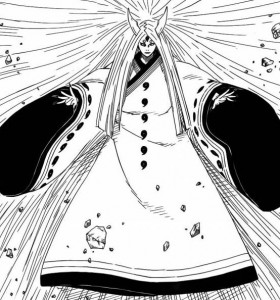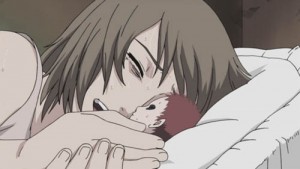Thought Naruto ended last November when the long-running manga series concluded? Think again! Like some of its immortal characters, this series won’t die. Not only is the anime adaptation still airing, Kishimoto launched the Naruto Project, a multimedia extravaganza consisting of movies, novels, a stage play, and a sequel manga miniseries about the next generation of Konoha ninja. Looks like there will be lots of material to discuss for a long time.
So, while we’re here, let’s discuss the origin of the ninja world presented in Naruto. No, I’m not talking about how a princess from a “far away land” ate the fruit of a mystical tree, thereby gaining chakra. Nor am I talking about how she passed chakra to her sons or how one of those sons would go on to create the martial arts used by the ninja in the series.
I’m talking about how the world of Naruto is one characterized by war, violence, and a thirst for power, and how it is ultimately reflected in the relationships mothers have with their sons.

As I previously alluded to, the ninja world began when Kaguya Ootsutsuki ate the fruit of the Chakra Tree. This gave her immense power, allowing her to end the wars tearing mankind apart. Although it was essentially by force, Kaguya brought peace to the world.
But you know what they say about absolute power corrupting absolutely. Kaguya bore twin sons, who inherited chakra from her and demonstrated that it could pass on from parent to child. A normal mother would be excited about her child’s latent talents. Not Kaguya. She hated that her sons could wield chakra and tried to take it back. And thus, the bringer of peace transformed into a harbinger of bloodshed.
Her sons fought her and ultimately ended her reign of terror, but ironically this would set the stage for the cycle of violence that characterized the ninja world until the coming of Naruto Uzumaki. Kaguya ended wars by wielding the power she’d gained from eating the chakra tree, but that’s just suppressing violence with further violence. It’s a pattern that pops up continually throughout the series:
- Kaguya’s elder son created ninshuu in the hopes of establishing peace between men. Unfortunately, people used it to fight, changing ninshuu to ninjutsu.
- The Senju clan founded the village of Konoha in order to bring stability to the country, but other countries would later adopt the system of hidden ninja villages. This resulted in government-sanctioned violence, espionage, and sabotage for the purposes of economic gain. It’s also very important to note that the ninja villages don’t just work for the country they’re located in. They’re hired to do jobs for other countries as well. In reality, the balance of power between countries is determined by the martial power of the hidden ninja villages.
- Akatsuki planned to bring peace to the world by stealing the tailed monsters belonging to each country—killing the monsters’ hosts in the process—and starting the fourth ninja war.
- Sasuke intended to destroy the current flawed system by killing all influential figures and somehow rebuilding on top of the blood that would be spilled.
History can’t help but to repeat itself in Naruto.
In final chapters of the series, Naruto and his allies face off against the resurrected Kaguya. He later says he’s glad she wasn’t his mother, that Kaguya was cold and distant. And it’s that comment that illuminates how the relationships between mothers and sons serve as pivot points throughout the series.
Given that Kaguya tried to kill her sons, because she envied their ability to wield chakra, we can assume the relationship between them wasn’t the best. The fact that the sons chose to fight her also speaks volumes for the values she instilled in them. What does it say when their solution to ending violence is to seal their mother away in the moon?
We also see the effect of maternal feelings upon sons in Gaara and Naruto. These two were deliberately set up as mirror characters. Both serve as hosts to tailed beasts, but because Naruto was able to form connections with the people around him, he overcame the overwhelming hatred the monsters bestowed upon their hosts.

Gaara, on the other hand, grew up an unwanted child. His mother, Karura, died giving birth to him. His uncle tried to assassinate him. We eventually discover the truth behind these circumstances, but the reality makes matters worse. People manipulated the truth to make Gaara a vessel of hate. He was told that Karura died hating his very existence. For a child well-aware of the causes leading to his mother’s death, this lie proved easy to believe. And when that child grew up isolated, hated, and feared by everyone, it’s no surprise he’d become a homicidal sociopath.
Naruto’s mother, Kushina, also died on the day her son was born. Not because of childbirth; if outside forces hadn’t come to cause mayhem, she probably would have survived. Konoha had a different philosophy when it came to the hosts of their tailed beast Kurama—better known as Kyuubi the nine-tailed fox. The hosts operated on the belief that they must live a life filled with love, because that was the only way to counter Kurama, who was viewed as the embodiment of hate. Kurama’s first host established this ideal. His second host, Kushina, followed it. The chain was broken with Naruto, the third host, due to Kushina dying when he was an infant and the entire village hating him, but that was accounted for. His mother left a piece of herself in the seal keeping Kurama in check, which when activated under a specific set of circumstances allows her to meet Naruto.
In contrast to Kaguya and her cold demeanor, Kushina is an approachable, good-natured mother. Despite having never even seen a picture of her, Naruto recognizes her. They have the same face. They have the same personality. They even have similar verbal quirks. There’s an immediate connection, and for Naruto, who has only ever wanted to form relationships with other people, it was a dream come true to meet his mother. It’s refreshing to see a son so excited to meet his mother and to think she is the most awesome thing ever.

In Naruto, the tailed beasts are considered monsters. They’re put into hosts to control them, and they’re allocated to various ninja villages in a delicate balance of power. They’re the equivalent of biological weapons. They’re monsters first, people second. As a result, the hosts are dehumanized. The ninja council of Sunakagure wanted the ultimate weapon and saw their chance in Gaara. From lying to him about his mother’s love to ordering his maternal uncle to betray him, they stripped Gaara piece by piece of his interpersonal relationships in order to strengthen his control of the tailed beast inside him. This led to his isolation, which only fed his rage against the world, and that rage only further ostracized him from other people. Even his own siblings feared him.
On the other hand, even though Konoha hated Naruto for having the nine-tailed fox inside him, they never dehumanized him. It wasn’t something that was done. They never intended to use their tailed beast as a weapon. He was sealed away to keep the rest of the world safe. Kushina’s death was the result of someone trying to steal that weapon for themselves. The anger the village felt toward Naruto was personal: Kurama destroyed the village and killed their beloved leader. Even then, only the adults truly hated him. Naruto’s generation disliking him arose from them picking up on their parents’ feelings; they had no context.
Naruto’s desire to connect with other people, to understand them, is the key to why his character ultimately becomes a vehicle for changing the ninja world. Because he was never dehumanized in the way Gaara was; he acted out by pulling pranks, not by killing people. After all, you generally can’t connect with people if they’re dead! For a long time, he wasn’t even aware he was a host. In many way, this freed him because that knowledge is a burden upon a child. And as Gaara demonstrates, sometimes they break under that weight.
If Kaguya’s distant relationship with her sons played a role in creating the world, the lies about Karura’s feelings toward Gaara reflect the status quo of it; Kushina’s overwhelming love and joy for Naruto save him from impending disaster. Naruto is a series about connecting with other people. Multiple characters comment on Naruto’s strange ability to make others want to walk with him. It’s what allowed him to befriend all nine tailed beasts. It’s what helped him finally realize his dream of becoming hokage. It’s what contributed to his ushering in an unprecedented time of peace. The next generation of ninja need not worry about forcing people to become biological weapons. In the world Naruto ushers in, mothers can raise their children via relationships that are contentious only in the most normal of ways.
And that is his ninja way.

